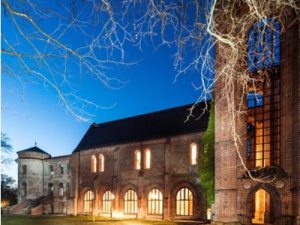 Breathing new life into a 13th Century historical building is always going to present challenges, however, thanks to the installation of a unique acoustic ceiling and lighting scheme, the end result at Dargun Abbey, northern Germany, is nothing short of miraculous.
Breathing new life into a 13th Century historical building is always going to present challenges, however, thanks to the installation of a unique acoustic ceiling and lighting scheme, the end result at Dargun Abbey, northern Germany, is nothing short of miraculous.
Once a ruin that only made it onto the former GDR’s central register of listed monuments, thanks to the tireless efforts of campaigners, the Abbey has undertaken a spectacular transformation and is now a sought after location for concerts, private art installations and corporate conferences thanks to its lighting and acoustic refurbishment.
Initial renovation and redevelopment work in 1991 saw the Abbey receive a new roof, windows and doors. However, due to the hall’s design, the acoustics presented significant challenges, as did the ageing lighting. Architect for the scheme, Martin Beyer of Beyer Architekten, comments: “Even in full daylight, the Abbey was uninviting and its ambience just didn’t fit with the impressive building. It was crying out to be presented in a new way.”
Following an expert evaluation, the planners decided that instead of installing a flat ceiling the ideal solution would be to incorporate a ceiling made of acoustic textile fabric that would reflect the character of the destroyed original Gothic cross vault. Never seen before in a German installation, three self-supporting textile canvasses, each measuring 10×10 metres, were stretched over an aluminium structure and attached to the walls. “In contrast to a flat ceiling, this high-tech canvas solution creates drama within the Abbey and mimics the vault’s original geometry, as well as dramatically improving the Nave’s acoustics,” explains Martin Beyer.
Similarly, a lighting solution was required that could be integrated into the existing old masonry, that did not have a detrimental impact on this heritage building and was also easy for the Abbey’s users to operate. Following digital 3D analysis, the planners ultimately decided on Lutron’s Homeworks QS, as its installation would minimise damage to the Abbey and could be programmed with pre-set scenes to suit any entertainment requirement.
The lighting solution has created an atmosphere that combines tradition and modernity with impressive results. In addition to three chandeliers, a total of 28 dimmable halogen lamps have been installed. The medieval masonry caused issues for the planners and installers. “There are no right angles in the abbey,” says Detlef Jeenicke, who contributed to the project in an advisory capacity as a representative for Lutron and for Spittler Lichttechnik, the manufacturer of the lighting solution. “The challenge was to illuminate irregular surfaces with straight beams.” There were other difficulties, too. The walls, that are roughly one metre thick, proved too robust for drilling. One of the effects of this was that the WLAN router, a key element for controlling the lighting technology, had to be positioned inside the abbey rather than outside. It is now located directly underneath the organ.
“The architect and the building owner chose Lutron’s Homeworks QS system as, due to its flexibility, all of the client’s wishes could be met,” says Detlef Jeenicke. “For example, it allows different lighting scenarios to be set up very easily without requiring additional programming.” A total of eleven different lighting scenes are pre-installed and offer ideal lighting conditions for tours, church services, readings, weddings and other events.
The Homeworks QS control unit is located in a side room of the abbey and can be operated conveniently via WLAN using an iPhone or an iPad. Another advantage is the system’s efficiency. Lutron’s solution ensures that even when the halogen lamps are at maximum brightness only 90% of their power is required. This deliberate reduction leads to considerably longer service lives for the lamps, without placing any constraints on the users, who can still dim the lamps to between 1% and 100% as usual. The system also offers four DMX circuits. Thanks to these interfaces, external sound and lighting engineers can easily integrate their own equipment in the existing technical infrastructure – allowing them, for example, to call up their individual lighting scenes at events.
This echoing ruin has been transformed into a modern multi-purpose venue for up to 200 guests. It now hosts events ranging from church services to official city receptions, chamber concerts and art exhibitions. Thanks to Lutron’s innovative lighting control, Dargun Abbey can be illuminated flexibly to suit any occasion. The lighting lends the abbey interior an inviting atmosphere at any time of day. Jan Ewald from Lutron concludes: “The abbey at Dargun is a prime example of what can be achieved when lighting designers and architects work closely. The combination of acoustic ceiling and the lighting has breathed new life into this building.”

